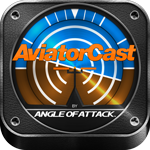
These days, the art of hand-flying seems to be a bygone era. Unfortunate as that may be, it’s the result of highly automated aircraft taking the flying opportunities from pilots. Catch 22 works in ironic ways, as the pilot is the one that has to turn on the autopilot in the first place, making him the creator of his own demise.
In the days of yesteryear, autopilot didn’t even exist. Even on the pioneering mail routes in early US aviation, aviators of the day flew long distances with no autopilot. Charles Lindbergh, as a similar example, flew his legendary trans-atlantic journey all by hand. Unbelievable.
Now, don’t get me wrong. I am a proponent of autopilot and the automation of today. I do believe that it adds to overall flight safety, so long as it’s used in a way for greater awareness, rather than the misinterpreted notion that somehow it increases safety itself. Such a notion leads to stupid decisions and deaths, even in aircraft with a parachute (yes, the aircraft has a parachute).
As an aviator, you must know how to fly the aircraft.
Here are 5 quick tips:
Easy Goes It!
When you are controlling the aircraft, it’s essential that you are smooth as silk. Jerking the controls around just to get the perfect indications isn’t going to make any of the passengers in the back happy. They expect a flawless, motionless feel to their flight.
Think about it-
Other than that push on takeoff and the halting of landing, do you ever really feel an airliner turn, or feel any abrupt and uncomfortable movement? Granted these aircraft are on autopilot most of the time, but you wouldn’t know the difference if the pilot was flying or the autopilot was flying.
That is because the pilots know that flying smooth, going easy with their movement, is key for passenger comfort. Something you too should strive for.
Anticipate
Think ahead to anticipate the next move. If you have a turn coming up, and it’s a sharp turn, ease into it. Remember that the sky isn’t a race track. You don’t have to build perfect curves around corners.
If you’re about to initiate a climb, a simultaneous and smooth increase in power will make the transition flawless.
By anticipating the movements ahead, coupled with smooth hand-flying, you’ll always have a smooth AND predictable flight path that is comfortable for all. This also prevents you from needing to make immediate corrections or drastically different courses of action.
Anticipation is a close cousin to one of the golden rules of flying: Always be ahead of the aircraft. You should always be ahead in your mind. As soon as the aircraft and your situation are getting out of control (both literally and mentally) is when you start making mistakes.
Practice Makes Perfect
I fully realize that many of you are busy with family, work, and other duties. Many of you also aren’t real pilots and only get to use your simulator once a week, and sometimes only a few times a month.
Hand-flying is a technique that requires practice- and lots of it. I heard the other day that flying is a ‘perishable skill’. This came from a dentist. I would certainly have to agree this is the case.
So here’s the drill- practice, practice, practice. When you can hand-fly, do it. If you’re not good now, you’ll get better. If you’re horrible now, you’ll get good.
Little-by-little, with practice, your skills will build. Eventually you will get yourself in a situation that requires this skill. Your instincts will kick in, you’ll do the perfect maneuver, and you will astonish yourself.
Fly for the Fun of It
Using a flight simulator, you can do some things that otherwise couldn’t be done in the real world. Say, flying inverted in a 737, or weaving through a canyon at 600 knots in an F-18. Believe it or not, these things will increase your skills as a hand-flyer. Apart from that, it’s a blast.
For you real world pilots, consider breaking out of the mold of countless cross countries and flying for a living, along those monotonous and repetitive routes.
Consider, every now and again, taking up the aircraft alone. Go solo. Just you, sky above, flowing scenery below, and the freedom to go anywhere.
Fly curious. Check out landmarks, rivers, mountains.
And do it all under your own command. Do it by hand.
Master Instruments
Interestingly enough, in contrast to VFR flying, is doing actual or even simulated instrument work.
As you start to gain more and more experience with instruments, you’ll notice flight characteristic intricacies your aircraft has, and flight in general. This can assist you tremendously in hand flying. You’ll anticipate better, fly smoother, and have a deep instinct of how the aircraft will react to your inputs.
Conclusion
Hand-flying is an artistic, perishable skill. If not practiced regularly, you’ll find much less joy in flying. You won’t know your aircraft. And, when put in a situation that requires that skill, you will fail if not proficient.
Commit today to hand-fly more. Disengage the autopilot and work through the frustration to build this skill.
Get to know your aircraft. It’ll make your flying days ahead much more enjoyable, and fulfilling.
![]()
Join the Conversation!
Are you good at hand-flying? Is it a skill that you’d like to build?
This article was posted in Aviation, Blog, Challenges, Flight Safety, Flight Simulator, Flightsim Tips, Microsoft Flight, Real World, Resources
Please note: We reserve the right to delete comments that are snarky, offensive, or off-topic. If in doubt, read the Comments Policy.

